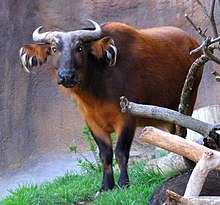African forest buffalo
| African forest buffalo | |
|---|---|
 |
|
| Scientific classification | |
| Kingdom: | Animalia |
| Phylum: | Chordata |
| Class: | Mammalia |
| Order: | Artiodactyla |
| Family: | Bovidae |
| Subfamily: | Bovinae |
| Genus: | Syncerus |
| Species: | S. caffer |
| Subspecies: | S. c. nanus |
| Trinomial name | |
|
Syncerus caffer nanus |
|
African forest buffalo (Syncerus caffer nanus), known also as the Congo buffalo, is the smallest subspecies of the African buffalo. It is related to the Cape buffalo (Syncerus caffer caffer), West African savanna buffalo (Syncerus caffer brachyceros) and Central African savanna buffalo (Syncerus caffer aequinoctialis). However, it is the only subspecies that occurs mainly in the rainforest of central and western Africa with an annual rainfall around 1,500 mm.
The African forest buffalo is a smaller variety of African buffalo. Cape buffalo weigh anywhere from 400 to 800 kg (880–1760 lbs), whereas African forest buffalo are much lighter, weighing in at 250 to 320 kg (550–705 lbs). Weight is not the only differentiation, however; this subspecies has reddish brown hide that is darker in the facial area. The shape and size of the horns distinguish forest buffalo from other subspecies. African forest buffalo have much smaller horns than their savanna counterparts, the Cape buffalo. Cape buffalo horns often grow and fuse together, but forest buffalo horns rarely fuse.
African forest buffalo live in the rainforests of Western and Central Africa; however, their home ranges typically consist of a combination of marshes, grassy savannas, and the wet African rainforests. Savannas are the area where the buffalo graze, while the marshes serve as wallows and help with the insects. Forest buffalo are very rarely observed in the unbroken canopy of the forests. They instead spend most of their time in clearings, grazing on grasses and sedges. Consequently, their diet is primarily made up of grasses and other plants that grow in clearings and savannas.
The mixture of habitats is essential for the forest buffalo. Expansion and encroachment of the rainforest on the surrounding savannas and openings are major difficulties of maintaining the ecosystem. Forest buffalo enjoy old logging roads and tracks, where the forest is thinner and grass and other foods can grow. In these areas forest buffalo depend on the grass that is able to develop as a result of the areas that have been previously clear-cut. In some areas park management staff burn off the savannas on a regular basis to keep the rainforest from growing onto the savannas and changing the ecosystem of the area.
Large home ranges can be associated with less-productive habitats; however, a larger area of open grassland has been observed to have a positive relationship with herd size. Home ranges remain remarkably constant and stable year after year. The only documentation of the actual home range boundaries of these animals is relatively recent, so only time can tell how these boundaries remain over large lengths of time; however, studies have shown almost no movement in range boundaries from one year to the next.
...
Wikipedia

